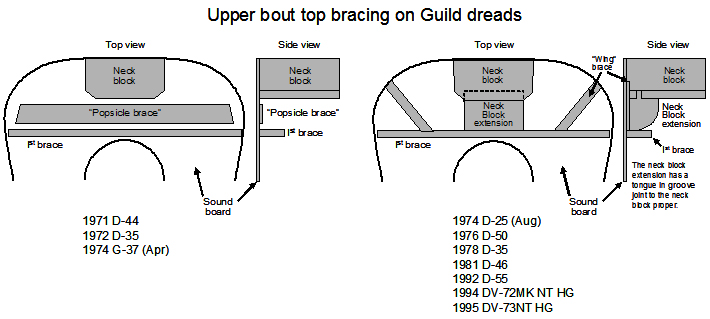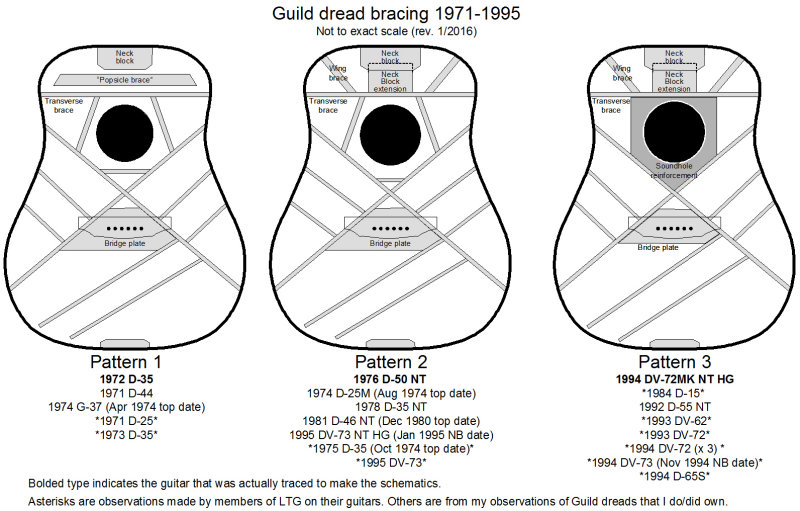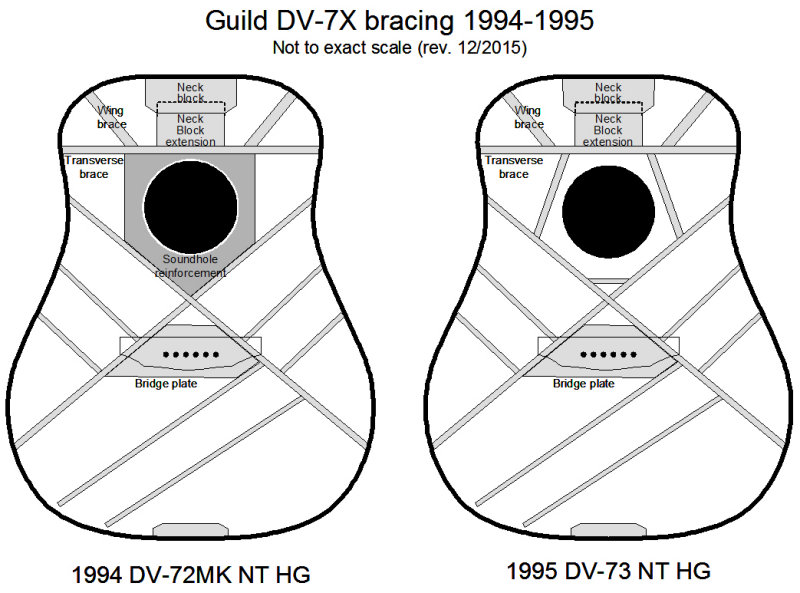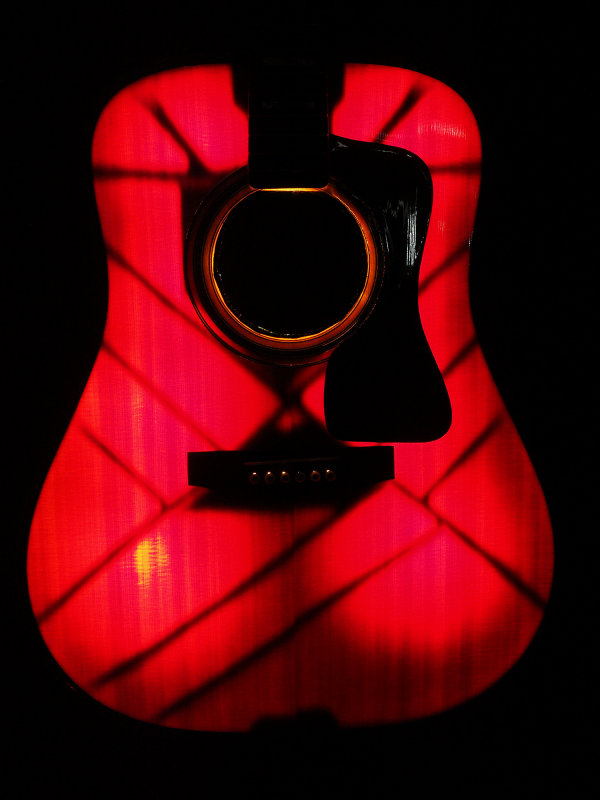GardMan
Enlightened Member
Altho’ my primary on-line guitar hangout is “Lets Talk Guild,” I have also spent a considerable amount of time over on the “Unofficial Martin Guitar Forum.” I have never joined UMGF, partly because I hear horror stories about the Yuko BB platform used, and also because I have no intention of ever buying a Martin guitar. But, I have learned a lot about guitar construction reading the technical threads… and found the Martin bracing library particularly interesting.One of the techniques that intrigued me, sometimes referred to as a “Henkogram”(for the UMGF member who advocated the technique), uses lights placed inside the guitar body to image the placement of the to braces thru the guitar’s top. The braces show as shadows in the image. I filed the technique away in my head, planning to try it out with my Guild dreadnaughts during some future string change. That was a couple years back...
Well, I finally got around to experimenting with the technique during my "semi-annual mass Guild string change extravaganza" over the holidays... I used 6-9 battery operated undercounter LED puck lights (from the local Lowes) placed in the body of each guitar (the guitars were on a stand, and the lights were balanced somewhat precariously on the back braces), a cardboard and black felt cover over the soundhole, and my digital camera on a tripod. Exposures ranged from 3 to 15 seconds for the images shown. The D-35 was my first attempt... too much ambient light made the flare on the treble side, and I only had 6 lights, leaving the neck block area somewhat underexposed. I went and bought another pack of 3 lights (3 for $10), and used 8-9 lights for the other images.

Individual detailed images can be found here...
A couple things to notice...
The change in upper bout bracing that occurred sometime in mid-1974 is apparent by comparing the '72 D-35 with all the others. The '72 D-35 has a thin transverse "popsicle brace" between the neck block and first transverse brace. In contrast, all the post 1974 Guild dreads have a neck block extension extending to the first transverse brace, flanked by thin "wing braces." I first encountered this change when looking around inside my '70s dreads a couple years ago, and posted a diagram (now revised).

My '74 G-37 Bld, with a top date of April 1974, had the popsicle brace, while my '74 D-25M, with a top date of Aug 1974, had wing braces. This pinpoints the change to sometime in mid-1974.
Next, you can see the shadow of the "soundhole re-inforcement plate" in my 1994 DV-72MK, compared to the separate braces surrounding the sound holes in all of the other dreads. My 1992 D-55 also had a sound hole plate... observations from other LTGers suggest this bracing pattern was in use between ~1984 and 1994.
Lastly, the positions of the lower bout braces and tone bars vary a bit... it's hard to tell if this variation from guitar to guitar, model specific, or year specific. But, at first glance, it appears as if the '76 D-50 and '81 D-46 bracing patterns are quite similar, while those on the two DVs are somewhat more similar to that of the '72 D-35. So, here's a revised sketch of the Guild bracing patterns I have observed (the tone bar differences in different guitars with pattern 2 aren't really shown)...

The last image shows diagrams specifically comparing the bracing in my '94 DV-72MK and '95 DV-73:

Well, I finally got around to experimenting with the technique during my "semi-annual mass Guild string change extravaganza" over the holidays... I used 6-9 battery operated undercounter LED puck lights (from the local Lowes) placed in the body of each guitar (the guitars were on a stand, and the lights were balanced somewhat precariously on the back braces), a cardboard and black felt cover over the soundhole, and my digital camera on a tripod. Exposures ranged from 3 to 15 seconds for the images shown. The D-35 was my first attempt... too much ambient light made the flare on the treble side, and I only had 6 lights, leaving the neck block area somewhat underexposed. I went and bought another pack of 3 lights (3 for $10), and used 8-9 lights for the other images.

Individual detailed images can be found here...
A couple things to notice...
The change in upper bout bracing that occurred sometime in mid-1974 is apparent by comparing the '72 D-35 with all the others. The '72 D-35 has a thin transverse "popsicle brace" between the neck block and first transverse brace. In contrast, all the post 1974 Guild dreads have a neck block extension extending to the first transverse brace, flanked by thin "wing braces." I first encountered this change when looking around inside my '70s dreads a couple years ago, and posted a diagram (now revised).

My '74 G-37 Bld, with a top date of April 1974, had the popsicle brace, while my '74 D-25M, with a top date of Aug 1974, had wing braces. This pinpoints the change to sometime in mid-1974.
Next, you can see the shadow of the "soundhole re-inforcement plate" in my 1994 DV-72MK, compared to the separate braces surrounding the sound holes in all of the other dreads. My 1992 D-55 also had a sound hole plate... observations from other LTGers suggest this bracing pattern was in use between ~1984 and 1994.
Lastly, the positions of the lower bout braces and tone bars vary a bit... it's hard to tell if this variation from guitar to guitar, model specific, or year specific. But, at first glance, it appears as if the '76 D-50 and '81 D-46 bracing patterns are quite similar, while those on the two DVs are somewhat more similar to that of the '72 D-35. So, here's a revised sketch of the Guild bracing patterns I have observed (the tone bar differences in different guitars with pattern 2 aren't really shown)...

The last image shows diagrams specifically comparing the bracing in my '94 DV-72MK and '95 DV-73:

Last edited:
